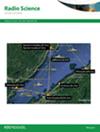互补频率选择曲面分析技术的提出
IF 1.6
4区 地球科学
Q3 ASTRONOMY & ASTROPHYSICS
引用次数: 0
摘要
一类特定的频率选择表面(FSS)是具有高角度稳定性、多个透射和/或反射带以及小型化可能性等有趣特性的互补频率选择表面。这类结构的分析和设计通常使用商业软件进行,这需要很高的计算工作量,影响更长的优化时间。等效电路模型与级联技术相结合,是使用这些软件优化这些结构的物理尺寸的一种替代方法,因为它们除了能够用各种编程语言实现外,还可以用低计算工作量和优化时间来建模CFSS的行为。因此,本文提出了一种将等效电路法与ABCD矩阵相结合的CFSS分析技术。据我们所知,这是第一篇关于CFSS分析近似技术的研究报告。由于高度的角度稳定性和偏振独立性,所选择的几何形状是圆环。介绍了贴片和孔径几何的等效电路建模。对一些结构进行了模拟,并将结果与HFSS软件的结果进行了比较。最后,建立了两个原型来验证所执行的分析。本文章由计算机程序翻译,如有差异,请以英文原文为准。
Proposal of technique for analysis of complementary frequency selective surfaces
A specific class of frequency selective surface (FSS) is the complementary frequency selective surface (CFSS) that has interesting characteristics such as high angular stability, multiple transmission and/ or reflection bands, and the possibility of miniaturization. The analysis and design of this sort of structure are commonly performed using commercial software, which demands a high computational effort, impacting a longer optimization time. The equivalent circuit model combined with a cascading technique emerges as an alternative method to the use of these softwares, in the optimization of the physical dimensions of these structures, as they model the behavior of a CFSS with low computational effort and optimization time, in addition to being able to be implemented in various programming languages. Thus, this work proposes a CFSS analysis technique that combines the equivalent circuit method with the ABCD matrix. To the best of our knowledge, this is the first reported research on approximate techniques for CFSS analysis. The chosen geometry was the circular ring, due to high angular stability and polarization independence. The modeling of the equivalent circuit for patch and aperture geometries is presented. Some structures are simulated, and the results are compared with results obtained with the HFSS software. Finally, two prototypes are built to validate the analyses performed.
求助全文
通过发布文献求助,成功后即可免费获取论文全文。
去求助
来源期刊

Radio Science
工程技术-地球化学与地球物理
CiteScore
3.30
自引率
12.50%
发文量
112
审稿时长
1 months
期刊介绍:
Radio Science (RDS) publishes original scientific contributions on radio-frequency electromagnetic-propagation and its applications. Contributions covering measurement, modelling, prediction and forecasting techniques pertinent to fields and waves - including antennas, signals and systems, the terrestrial and space environment and radio propagation problems in radio astronomy - are welcome. Contributions may address propagation through, interaction with, and remote sensing of structures, geophysical media, plasmas, and materials, as well as the application of radio frequency electromagnetic techniques to remote sensing of the Earth and other bodies in the solar system.
 求助内容:
求助内容: 应助结果提醒方式:
应助结果提醒方式:


